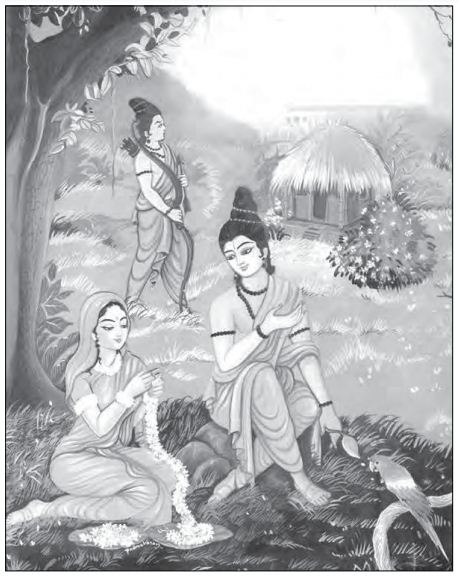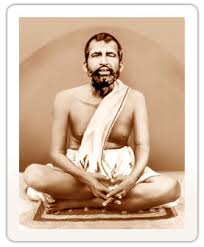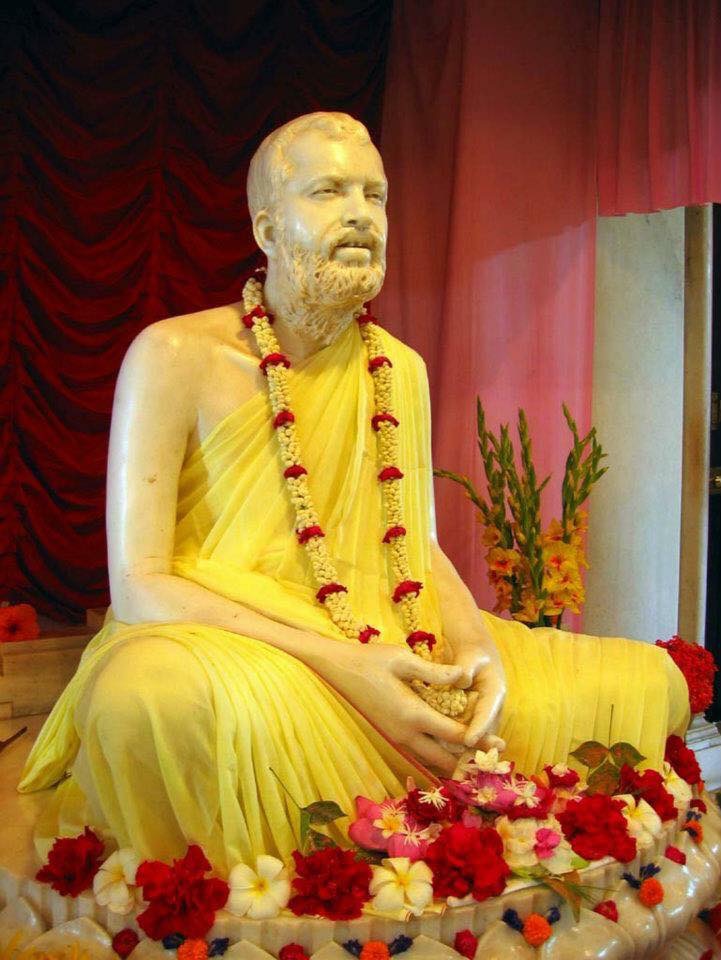Adhyatma Ramayana and Sri Ramakrishna
Adhyatma Ramayana is a book Sri Ramakrishna was fond of and cited frequently in his conversations. In his early days of Sadhana at Dakshineswar, he used to listen to his friend Krishna Kishore read the book, and to his cousin, Haladhari. The context for these references, mostly, was the question of the nature of God which his devotees often brought up. In Sri Ramakrishna’s time the chief contenders on the issue were the Brahmos, ‘the modern Brahmajnanis’ as he called them, who insisted that God was formless, and orthodox Hindus, who believed that God assumes many forms. Sri Ramakrishna’s great life and unsurpassed realizations infused new life into both groups.
However Sri Ramakrishna often seemed to be lending weight to the orthodox side pitted against the onslaught of missionaries and new generation educated in Christian institutions. The futile attempts of trying to speculate on the nature of God had been brought home to the author of the Gospel by the Master at the very beginning of their acquaintance. He had warned Mahendranath Gupta at their second meeting, ‘Remember that God with form is just as true as God without form. But hold fast to your own conviction.’1 Much later he put his own position in a telling phrase: ‘Jnana and Bhakti are one and the same thing. The difference is like this. One man says “water” and another says “block of ice.”’2
What endeared the Adhyatma Ramayana to him was this harmony of Jnana and Bhakti in it. When it was reported to him that Keshab’s disciples claimed that Keshab was the first harmonizer of Bhakti and Jnana he exclaimed: ‘How is that? What then of the Adhyatma Ramayana?’3
Sri Rama—the Unique Incarnation
Adhyatma Ramayana achieves this harmony by accentuating, in equal measure, both the divine and human sides of Sri Rama’s personality. This is in contrast to Srimad Bhagavatam which presents Sri Krishna as God himself. His humanity, like the smudge in the full moon, only adds to his divine splendor. In Sri Rama’s case it is just the opposite. He is Brahman, ‘weeping ensnared’ in maya. Among the incarnations Hindus worship, he is the one who wears the crown of thorns. The Srimad Bhagavatam puts the idea in poetry with an elegiac note:
Rama withdrew Himself into His pristine state of light, leaving in the hearts of those who meditate upon Him, the imprint of His feet, tender like fresh leaves, all cut and torn with the thorns of the deep jungles.4
There is a striking resemblance between Sri Ramakrishna and Sri Rama. He was Rama first and Krishna only next. In both, humanity and divinity ebbed and flowed alternately, as the river and the sea in an estuary. Sri Ramakrishna asked M, ‘Well, why have I this illness?’ M replied, ‘People will not have the courage to approach you, unless you resemble them in all respects. But they are amazed to find that in spite of such illness you don’t know anything but God’. The Master answered with a smile: ‘Balaram also said: “If even you could be ill, then why should we wonder about our illness? Lakshmana was amazed to see that Rama could not lift his bow, on account of his grief for Sita. Even Brahman weeps entangled in the snare of the five elements.”’ 5 The Master himself used to say that there are two persons in his body, the Mother and her devotee and it is the devotee who is ill. It is difficult to recognize an incarnation because of this very reason and it has engendered a major dispute between the Jnanis and the Bhaktas.

We see God Himself if we but see His Incarnation6
The disbelief in God incarnating as man is older by ages than the skepticism of our times. The Adhyatma Ramayana begins with Parvati questioning Shiva on the truth of the incarnation:
It is well known that devotion to Rama is the ship that ferries one across the ocean of samsara. But I have some reservations about giving my heart’s love and devotion freely to him. . . Rama is said to be the primeval reality transcending maya. Knowing him to be so, people worship him to attain to the supreme state. But others say that he did not know he was Brahman owing to the power of his own maya (Avidya) . . . [If he had known his own true identity] how could he be grieved at the loss of Sita, He being no better than any other man ignorant of his true self, Atman [how can he be a fit object for worship?]’7
Parvati is not a skeptic like Dr. Sarkar, who was Sri Ramakrishna’s physician. He dismisses the very idea: ‘Incarnation! What is that? To cower before a man who excretes filth!’8 Mother Parvati is more like the Brahmo devotee Trailokya, who said: ‘There cannot be a manifestation of infinite power. It simply isn’t possible. It is impossible for any man to manifest infinite powers.’9 The Brahmo Samaj preached a God endowed with auspicious qualities like love and mercy but without form.
To the agnostic Dr. Mahendra Sarkar on the other hand God was an abstract principle, the hypothesis of a prime mover, which the empirical sciences he championed had rendered unwarranted. He would rather have the Buddha called the incarnation of compassion rather than Vishnu, as he remarked to Girish commenting on the latter’s drama ‘Life of the Buddha.’ ‘If you seek God, then seek Him in man; He manifests Himself more in man than in anything else.’10
The human incarnation is the most authentic and impressive manifestation of the reality of God. ‘Do you know why God incarnates as man? It is because through a human body one can hear his words.’11 ‘It is God alone who incarnates Himself as man, to teach people the ways of love and knowledge,’12 says Sri Ramakrishna.
Referring to hymns of Ahalya and Vibhishana,13 addressed to Rama, Sri Ramakrishna says, ‘Whole and part are like fire and its sparks. An incarnation of God is for the sake of the Bhaktas and not for the Jnanis. It is said in the Adhyatma Ramayana that Rama alone is both the Pervading Spirit and everything that is pervaded.’ ‘You are the supreme Lord distinguished as the vachaka, the signifying symbol and the vachya, the object signified.’ Captain, a devotee, asks: The ‘signifying symbol’ means the pervader, and the ‘object signified’ means the thing pervaded. Master’s reply: ‘The pervader in this case is a finite form. It is God incarnating himself as a human being.’14
The Master is unambiguously equating all aspects of Godhead with the finite form of Sri Ramachandra. In assuming a form He is not altered; He is only reaching out to the Jiva in his mercy. That is why Kausalya says: ‘Lord, in your womb the many world systems appear as atoms, yet you yield yourself to nature to be born in my womb. I now see your great concern on account of your devotees.’15
In his last days, when he could only speak with difficulty, Sri Ramakrishna conveyed by a gesture to Narendra that all created objects have come from him. When Narendra said he understood him and repeated what the master said, his face beamed with joy.16 Sri Ramakrishna says, ‘However great or infinite God may be, His essence can and does manifest itself through man by His mere will. God’s incarnation as a man cannot be explained by analogy. One must feel it for oneself and realize it by direct perception. An analogy can give us only a little glimpse.’17 ‘The incarnation is the play of the Absolute as man. Do you know how the Absolute plays as man? It is like the rushing down of water from a big roof through a pipe; the power of Satchidananda—nay Satchidananda itself—descends through the pipe’.18 This is Sri Ramakrishna’s unambiguous answer to Trailokya; it is a reassertion of Shiva’s assurance to Parvati.
Both answers imply that Satchidananda cannot be quantified into part and whole or large and small. The form of Sri Ramachandra does not limit the partless whole of Satchidananda, as the wave does not limit the ocean both being a continuum, but only conveys and manifests it to the Jiva inescapably trapped in a maze of sense perceptions. ‘God reveals Himself to his devotees in a tangible form, which is the embodiment of spirit,’ says Sri Ramakrishna.19
Embodiment of Compassion
Not the Buddha alone but all great incarnations are incarnations of compassion which is the chief of God’s infinite attributes, for his creation. A Jiva feels overwhelmed, when God condescends to come to him unsought to deliver him from the bonds of maya, in his mercy. Ahalya was the daughter of Brahma, and was married to the great sage Gautama. In spite of the spiritually elevated company in which she was born and brought up she sinned. Rama redeemed her and overwhelmed by the mercy of Sri Rama, she declares ecstatically, ‘I ever adore, of all the forms the Lord has assumed, that of the beautiful Rama, lotus-eyed and holding the bow, and none else.’20 A frail woman like her has been blessed with the grace of the Lord which is beyond the reach of even yogis.21 Ahalya’s sin was the Lord’s grace in disguise.
Rama sought out the cloistered hermit Sarabhanga who was longing to see him, of his own accord. The devotee said to himself, ‘Who is more merciful than Rama, who has come to me, knowing by intuition that I have been thinking only of him.’22 Suteekshna, Agastya’s disciple, whom Rama meets next says the same thing. ‘You are beyond the knowledge of all beings. Bound by thy maya, I have fallen in this blind ditch of family life with affection for wife and children and to my own body filled with filth. Seeing my helplessness you have come to me of your own accord.’23
Harmony of Bhakti and Jnana
Harmony presupposes discord. There cannot be any discord between love of God and knowledge of God. Knowledge requires an object, and God is the eternal Subject, ‘of the nature of pure witness consciousness.’24 One who tries to measure God, weigh Him and record facts about Him will only melt in Him and be He, as the salt doll that went to measure the ocean. To know God is to love God, to be God. Rama said to Lakshmana: ‘Brother wherever you find people singing and dancing in the ecstasy of divine love, know for certain that I am there.’25
Sri Ramakrishna says, ‘By constantly meditating on God the Bhakta loses his ego; he realizes that God is he and he is God.’26 Sri Rama assures Sabari, ‘The very instant bhakti is born in one, the truth about my nature also dawns. . . . So it is certain that bhakti is mukti.’27 ‘If the spiritual seeker is not motivated by love for Me’, says Sri Rama at the very start of the epic, ‘every scripture he looks up to for guidance will deceive him.’28 And Sri Ramakrishna says that that no scripture is necessary if the seeker has sincere yearning for God. The dispute is between those who lack that.
Ramaleela—The Play of Rama
The Great God Mahadeva said in reply to Parvati’s question about the truth of Rama:
Rama is the supreme self, the all comprehending Purushottama. Though he is inside and outside pervading all like ether, he is hidden from their vision, as He is their innermost self. He is the ultimate seer and witness of all this universe of his Maya’s creation. Before Him the whole universe whirls as iron filings round a magnet. The unintelligent with their minds covered by the power of ignorance, know this not. Ignorant Jivas superimpose their own ignorance and see him involved in worldly entanglements like themselves.29
There cannot be a story with the protagonist standing in the middle and all others whirling around. The action of a story should develop along a line, with a start and a finish.
It cannot go round and round in a circle. It should be the story of man going towards God or God coming towards man. ‘Rama does not come and go; he does not grieve; has no desire; does nothing. He is the very embodiment of changeless bliss.’30 ‘Just as the child playfully whirling round the pillar holding it with one hand finds the whole house whirling round, so do men superimpose the action on the supreme self and delude themselves.’31
So the story is of all Jivas whirling about and clashing with one another not knowing that the happiness they seek is God alone until He comes and reveals Himself. He ever dwells in man’s heart. ‘Attached as they are to their own wife and children, and engrossed in the struggle to earn a living, they do not remember Rama dwelling in their hearts, as a man forgets the necklace he wears round his neck and looks for it everywhere.’32 So the story is not of the Supreme Self, Sri Rama, but of the Jivas rushing toward Him through truth—‘from lower to higher truth’.
Who else but He who started the whole drama, deluding the Jivas with His maya? Sita tells Hanuman the whole secret at the very start of the epic: ‘I am the Primeval Prakriti and whatever I create by the power of his mere presence, is attributed to Him by ignorant people.’33 Almost every hymn in the book ends with the prayer ‘let not thy maya delude me’, for if he wanted he could have willed it otherwise. Why didn’t he? Nobody has the final answer. But Swayamprabha has the answer that will please devotees, who do not care to know why: ‘You the birthless and deathless one took birth so that devotees may be saved listening to the story of your deeds. O Raghottama, let those who want to, learn your truth. (But for me) may this form of yours ever shine in my heart.’34
How else could God, the truth beyond mind and speech, be contemplated upon?
References
1. The Gospel of Sri Ramakrishna, p80 (Hereafter Gospel and page number)
2. Gospel, p.812
3. Gospel, p.421
4. Bhagavatam, 9.10.4
5. Gospel, p.837
6 Gospel, p.726
7. Adhyatma Ramayana, I- 1- 10to15 (Hereafter A.R.)
8. Gospel, p.852
9. Gospel p.758
10. Gospel, p.726
11. Gospel, p.782
12. Gospel, p.392
13. A.R.I- 5, 53 and VI- 3- 19
14. Gospel, p. 789
15. Bala Kanda 3.25
16. Gospel, p.945
17. Gospel, p.725
18. Gospel, Pp.358-59
19. Gospel, p.670
20. A.R.I-5-46
21. A.R.I-5-43
22. A.R. III-2-7
23. A.R III-2-28
24. A.R. VI-13-10
25. Gospel, p.310
26. Gospel, p.700
27. A.R.III-10-29to31
28. A.R. I-1-51
29. A.R. I-1-17to19
30. A.R. I-1-43
31. A.R. I-1-22
32. A.R. I-1-20
33. Bala Kandam, Sargal sl.34
34. A.R.IV-6-73 and 65&66
Source : Vedanta Kesari, December, 2015



